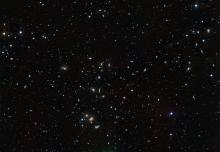Listen to today's episode of StarDate on the web the same day it airs in high-quality streaming audio without any extra ads or announcements. Choose a $8 one-month pass, or listen every day for a year for just $30.
You are here
Fastest Nova
A star system in Hercules almost seemed embarrassed. A couple of years ago, it grew thousands of times brighter in just a day or so. But then it started returning to normal faster than any system of its type yet seen.
V1674 Herculis is a binary — two stars locked in orbit around each other. One of the stars is a white dwarf — the dead core of a once-normal star. The other is in the prime of life. The two stars are so close together that the white dwarf pulls gas from its companion. As the gas piles up on the white dwarf, it’s heated and squeezed. In June of 2021, that triggered an explosion — a nova.
It usually takes weeks for such an eruption to fade by much. But V1674 dropped to a small fraction of its peak brightness in just a couple of days.
A recent study suggested that the gas that stacked up on the white dwarf mixed into the dead star. That triggered a nuclear explosion below the surface, blasting out material at two percent of the speed of light.
But not all of the gas erupted into space. Some remained on the white dwarf, adding to its mass. In fact, the star is so massive that it may be building up to a much bigger explosion. The star might blast itself to bits as a supernova — an outburst that will really draw attention.
V1674 Herculis is along the border between the constellations Hercules and Aquila. The system is high in the southwest at nightfall, but you need a telescope to see it.
Script by Damond Benningfield




